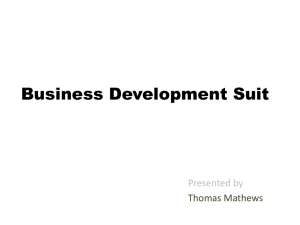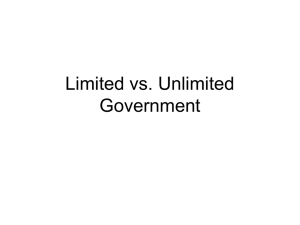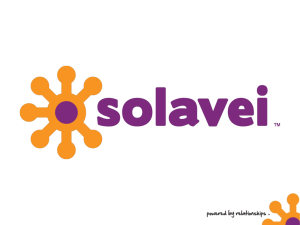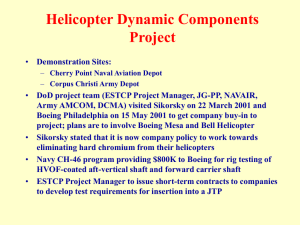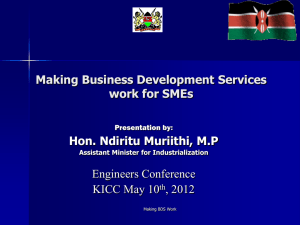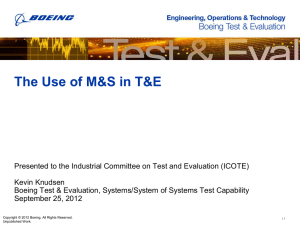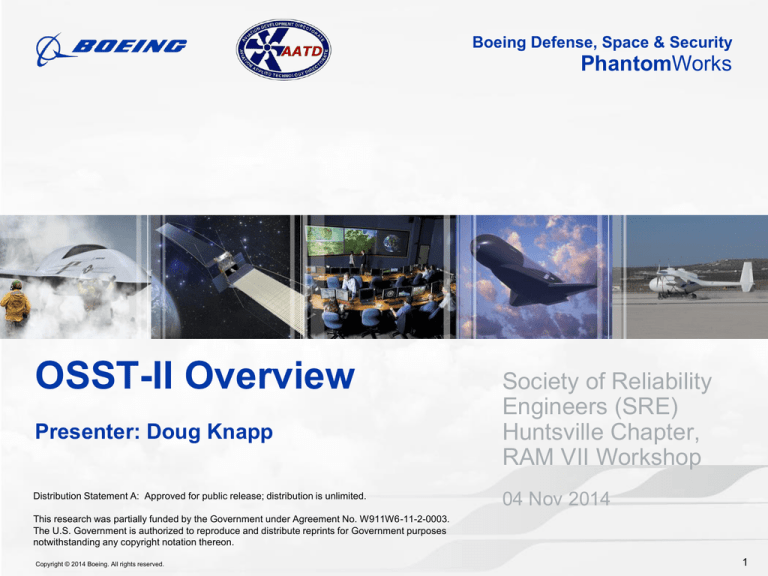
Boeing Defense, Space & Security
PhantomWorks
OSST-II Overview
Presenter: Doug Knapp
Distribution Statement A: Approved for public release; distribution is unlimited.
Society of Reliability
Engineers (SRE)
Huntsville Chapter,
RAM VII Workshop
04 Nov 2014
This research was partially funded by the Government under Agreement No. W911W6-11-2-0003.
The U.S. Government is authorized to reproduce and distribute reprints for Government purposes
notwithstanding any copyright notation thereon.
Copyright © 2014 Boeing. All rights reserved.
1
Operations Support and Sustainment
Technologies Phase II (OSST-II)
BDS | PhantomWorks
Background: Army desires to transition aviation fleet to
Condition Based Maintenance (CBM)
Purpose: Technology development and demonstration to
TRL4 (component and/or breadboard validation in laboratory
environment)
Objectives: Continue development and demonstrate 2016
Army S&T O&S metrics
Scope:
Electrical Project
Propulsion Project
VMS Project (Vehicle Management System)
Copyright © 2014 Boeing. All rights reserved.
Distribution Statement A: Approved for public release; distribution is unlimited.
2
CBM Program Objectives and Key Enablers
BDS | PhantomWorks
OSST-II Program supports Army CBM Program
Courtesy U.S. Army
Copyright © 2014 Boeing. All rights reserved.
Distribution Statement A: Approved for public release; distribution is unlimited.
3
Metrics
BDS | PhantomWorks
(2005 Fielded Aircraft Baseline)
(V) VMS
2016 S&T O&S Metric Goals
(E) Electrical
Contribution to 2016 Metric Goals (%)
(P) Propulsion
Predicted
contributions to 2016
Metric Goals
high
low
high
medium
medium
medium
medium
medium
medium
high
high
high
high
high
high
medium
medium
high
medium
medium
nil
65% Reduction in Inspections/Flight Hour
15% Reduction in Maintenance Labor/Flight Hour
20% Increase Component Mean Time Between
Removals
Less than 3% False Removal Rates
25 Hour Detection Time Before Failure
10% Reduction in System and Installation Cost
10% Reduction in System Weight
high (>50%)
medium (20-50%)
low (<20%)
nil (no contribution, or negative contribution)
Copyright © 2014 Boeing. All rights reserved.
Distribution Statement A: Approved for public release; distribution is unlimited.
4
Transition (2011 Outlook)
BDS | PhantomWorks
Technology
demo
Boeing
product
capability
Rotorcraft
platforms
Courtesy U.S. Army, AATD 2011
Copyright © 2014 Boeing. All rights reserved.
Distribution Statement A: Approved for public release; distribution is unlimited.
5
Transition Lookahead
BDS | PhantomWorks
Copyright © 2014 Boeing. All rights reserved.
Distribution Statement A: Approved for public release; distribution is unlimited.
6
Electrical System ‒ Vision
BDS | PhantomWorks
Leverage the ubiquitous nature of the electrical system to
create a CBM communications infrastructure to enable low
cost, minimally intrusive and pervasive health management
(HM) for the vehicle.
Make the CBM infrastructure open and easy to use to
provide the flexibility and adaptability required for growth.
Develop CBM applications for selected subsystems based
on their inherent benefit and to demonstrate the utility of the
infrastructure.
Copyright © 2014 Boeing. All rights reserved.
Distribution Statement A: Approved for public release; distribution is unlimited.
7
Electrical System ‒ Tech Approach
BDS | PhantomWorks
Electronic circuit breakers (ECBs)
in a solid state power distribution system (PDS) is leveraged to
monitor electrical loads.
Ultra Wideband over Wire (Ultra WoW)
to implement a virtual bus to communicate CBM data from line
replaceable units (LRUs) that have a bus interface (e.g., Mil-Std1553).
Power line communications (PLC)
to move data from LRUs or major components that do not support a
bus interface.
CBM system
built upon an open, partitioned, plug and play software infrastructure
to reduce development and integration costs, and provide a platform
for future growth.
Copyright © 2014 Boeing. All rights reserved.
Distribution Statement A: Approved for public release; distribution is unlimited.
8
Electrical System ‒ Apache Applications
BDS | PhantomWorks
Three (3) CBM Demonstration Threads
Generator
Electrical generator bearing
Blower
ECS (Environmental Control System) Blower motor bearing and
foreign object damage (FOD)
Electronics
Power supply and inverter
Distance to fault for wiring
Copyright © 2014 Boeing. All rights reserved.
Distribution Statement A: Approved for public release; distribution is unlimited.
9
Electrical System Project Plan
BDS | PhantomWorks
Industry Partners; Leverage SBIR, IRAD funded technologies
Copyright © 2014 Boeing. All rights reserved.
Distribution Statement A: Approved for public release; distribution is unlimited.
10
Electrical System Demonstration
BDS | PhantomWorks
Demonstration Threads
Copyright © 2014 Boeing. All rights reserved.
Distribution Statement A: Approved for public release; distribution is unlimited.
11
Electrical System Demonstration
BDS | PhantomWorks
Boeing test stand
Aircraft equipment
Bearing
Cage
front half
Rivet
Generator Drive Stand
Driveshaft
Aircraft
Equipment
Rack
Test Bench Operator’s Station
AC and DC Load Banks
Copyright © 2014 Boeing. All rights reserved.
Distribution Statement A: Approved for public release; distribution is unlimited.
12
Electrical Power Demonstration System
BDS | PhantomWorks
Demonstration Threads
CBM Application
Enabling
Technology
PDS as a Sensor
Generator
Bearing
Blower Motor
Bearing
Monitor motor
current for health
indicator.
CBM System
Copyright © 2014 Boeing. All rights reserved.
Distance to
Fault
Provide data to
distinguish
arcing from load
characteristics.
Potential to host
DTF electronics.
Communicated
sensor/processed
data for health
indicator.
Ultra WoW
Powerline
Communications
Power Supply
and Inverter
Communicated
sensor data over
main power
feeder.
Common open,
partitioned, Plug
and play
infrastructure.
Communicated
sensor data over
existing power
wire.
Common open,
partitioned, Plug
and play
infrastructure.
Common open,
partitioned, Plug
and play
infrastructure.
Distribution Statement A: Approved for public release; distribution is unlimited.
Common open,
partitioned, Plug
and play
infrastructure.
13
Propulsion Project (Approach & Benefits)
BDS | PhantomWorks
OSST II Propulsion Design Targets
2013 Technology Goals and 2016
S&T O&S Metrics
Develop sensor platform to
measure multiple oil &
component parameters.
Integrate COTS sensor
technology.
Utilize wireless communications.
Develop prognostics through
embedded algorithms using
dynamic model of
components and fluid
conduits.
Bench test Advanced Sensor
Platform.
Demonstrate with MELB Engine
and Transmission.
Copyright © 2014 Boeing. All rights reserved.
Distribution Statement A: Approved for public release; distribution is unlimited.
14
Propulsion Project Plan
BDS | PhantomWorks
Industry Partners; Leverage SBIR, IRAD funded technologies
Copyright © 2014 Boeing. All rights reserved.
Distribution Statement A: Approved for public release; distribution is unlimited.
15
Sensor Parameters
BDS | PhantomWorks
*O=Oil Aging/Contamination, W=Water Contamination, B=Bearing/Gear Fatigue, G=Gear Pump
Degradation, F=Filter Loading, P=Pressure Regulation, C=Cooler Performance, L=Line Restriction
Copyright © 2014 Boeing. All rights reserved.
Distribution Statement A: Approved for public release; distribution is unlimited.
16
Mapping System Features to Metrics
BDS | PhantomWorks
System Feature
Multiparametric oil
properties
Critical oil debris
Flow rate, RPM
supply pressure
Oil temperature
Algorithms providing:
Signal processing,
Self-diagnostics,
data fusion,
physical/empirical models
Specific Benefit
OSST Impact
Lubricant
degradation, RUL
Extended oil intervals
Lubricant
contamination
Bearing/gear fatigue
Lube pump
performance, RUL
Lube / scavenge
filter loading, RUL
Copyright © 2014 Boeing. All rights reserved.
Earlier bearing/gear
fault indication with
less false-positives
Localize pump faults,
Improved maintenance
scheduling
Reduce inspection
65% per flight hour
15% reduction
in labor
20% MTBR
increase
< 3% False
removals
Increased filter life
utilization, improved
maint. scheduling
> 25 hr detection
time before failure
Localize cooler /
bypass valve faults
10% reduction in
installation cost
Localize sensor faults
10% reduction in
system weight
Cooler performance
Sensor built-in-test,
self-accommodation
Integrated nodes,
Wireless hub
Reduced oil
inspections
Related Metrics
Reduced weight,
integration effort
Reduced weight,
integration effort
Distribution Statement A: Approved for public release; distribution is unlimited.
17
Test Plan Overview (MELB Transmission)
BDS | PhantomWorks
Test 1 – Initial Checkout and Acceptance
Test 2 – Baseline Condition
Test 3 – Fault Condition A: Water Contamination
Test 4 – Fault Condition B: Bearing Debris, Static Flow
Test 5 – Fault Condition C: Bearing Debris, Dynamic Flow
Test 6 – Fault Condition D: Silica Dust, Dynamic Flow
Test 7 – Fault Condition E: Gear Pump Wear
Test 8 – Fault Condition F: Incorrect Lubricant Contamination
Copyright © 2014 Boeing. All rights reserved.
Distribution Statement A: Approved for public release; distribution is unlimited.
18
RR250-C30P Engine Demo
BDS | PhantomWorks
Hardware installed on RR250-C30
Supply-side
Sensor Node
Scavenge-side
Sensor Node
To Scav Filter
Supply Pump
Pressure Sensor
RR 250-C30
Test Article
From Engine
Sensor nodes plumbed into flex lines
Master hub mounting arrangement
Injector port for dirt and steel chips
Debris
Chamber
HM System
Mounting Plate
Master Hub
Enclosure
Sensor, Power,
Comm Connections
Copyright © 2014 Boeing. All rights reserved.
Distribution Statement A: Approved for public release; distribution is unlimited.
19
MELB Main Transmission Demo
BDS | PhantomWorks
Hardware installed via plumb lines, master hub, injector port
A
C
(A) MELB Transmission (retired on flight hours)
(B) OSST-II hardware installation, showing master hub unit
(C) OSST-II hardware installation, showing sensors and fluid connections
B
Copyright © 2014 Boeing. All rights reserved.
Distribution Statement A: Approved for public release; distribution is unlimited.
20
MELB Main Transmission Demo
BDS | PhantomWorks
Hardware installed via plumb lines, master hub, injector port
(A) OSST-II hardware installed in the vicinity of the slave gearbox unit.
(B) Clearance measurement near pump inlet/outlet ports.
(C) Fluid aeration within the gearbox sump while stopped.
Copyright © 2014 Boeing. All rights reserved.
Distribution Statement A: Approved for public release; distribution is unlimited.
21
VMS Project (Approach & Benefits)
BDS | PhantomWorks
OSST II VMS Design Targets 2013
Technology Goals and 2016 S&T
O&S Metrics
OSST VMS Design
CAPTURE
& ADAPT
ERDS
Block-III
Boeing
Programs:
CRAD
IRAD
CH-47
V-22
A160
LEVERAGE
A H-64
Copyright © 2014 Boeing. All rights reserved.
S-100
Contribution to 2016 Metric Goals (%)
2016 S&T O&S Metric Goals
(2005 Fielded Aircraft Baseline)
(V) VMS
Emerging AED Findings
• Selection of Higher Payoff CBM
Applications
• Analysis of No Fault Founds,
Intermittents and Extended
Troubleshooting
• Data Mining
• Performance Analysis of Actuators
• Development of Health Indicators
for Electro-mechanical and
Hydraulic Actuator
• Fault Patterns in Reasoner
• Vehicle Level Integration
• System Demonstration in Test
Facilities
(E) Electrical
RAM DRIVERS
(P) Propulsion
Vehicle Field Data
high
low
high
medium
medium
medium
medium
medium
medium
high
high
high
high
high
high
medium
medium
high
medium
medium
nil
65% Reduction in Inspections/Flight Hour
15% Reduction in Maintenance Labor/Flight Hour
20% Increase Component Mean Time Between
Removals
Less than 3% False Removal Rates
25 Hour Detection Time Before Failure
10% Reduction in System and Installation Cost
10% Reduction in System Weight
high (>50%)
medium (20-50%)
low (<20%)
nil (no contribution, or negative contribution)
Distribution Statement A: Approved for public release; distribution is unlimited.
22
VMS Project Plan
BDS | PhantomWorks
Industry Partners; Leverage SBIR, IRAD funded technologies
Copyright © 2014 Boeing. All rights reserved.
Distribution Statement A: Approved for public release; distribution is unlimited.
23
VMS Focus Areas (application categories)
BDS | PhantomWorks
Health Management & Analysis
Focus on No Fault Found (NFF) and maintenance event records
Utilized academia (Univ Tennessee, Vanderbilt Univ)
Yield relevant technology maturation for future development
est. <TRL4 for Apache application
Actuator Rigging
est. TRL4 auto rigging to reduce O&S burden
Actuator Prognostics
est. TRL4 diagnostics/prognostics for stabilator actuator
degradation
Copyright © 2014 Boeing. All rights reserved.
Distribution Statement A: Approved for public release; distribution is unlimited.
24
Actuator Prognostics Overview
BDS | PhantomWorks
Early Program Effort
These “new technology” efforts
concluded in 2012
Correlating Existing MDR and Unit Leven Logistics System Aviation (ULLSA) Data
Actuator Life on Wing Distribution (many early removals indicates shot gun
maintenance)
Correlation of Fault Codes to Removals (weak correlation, no forensics)
Estimating NFF Rate (extremely high)
Characterizing Degrading Actuators
Final objective and focus
of 2013-2014 testing and
analysis effort
TRL4 prognostics may
reduce instances of early
removals and NFFs
Copyright © 2014 Boeing. All rights reserved.
Distribution Statement A: Approved for public release; distribution is unlimited.
25
Actuator Prognostics Overview
BDS | PhantomWorks
Final Objective — to use the rates as a measurement of
degradation in the stabilator actuator, also known as ElectroMechanical Actuator (EMA)
Approach
By comparing the actuator commands and responses during the preflight IBIT test
portion for the flight data that is available, determine whether or not there are
observable degradations over time
Assuming that there are observable degradations over time, incorporate this
information into a failure prediction model
Develop an automated script to compare the command versus the response and look
at the margins in the test
Data was convincing as useful for performance evaluation
Copyright © 2014 Boeing. All rights reserved.
Distribution Statement A: Approved for public release; distribution is unlimited.
26
Actuator Prognostics Overview
BDS | PhantomWorks
Stabilator Actuator on aircraft
Copyright © 2014 Boeing. All rights reserved.
Distribution Statement A: Approved for public release; distribution is unlimited.
27
Actuator Prognostics Overview
BDS | PhantomWorks
Stabilator Actuator components
susceptible to wear
Motor commutation Brushes
DC motor bearings
Gear train wear
Gear train bearings
Limit switch failure.
Fault Modes
2 back-to-back
Stabilator Actuators
Typically slow degradation in
actuator drive rate with
(brush/bearing) wear out.
Increasingly large variance in drive
rate with wear out.
Copyright © 2014 Boeing. All rights reserved.
Distribution Statement A: Approved for public release; distribution is unlimited.
28
Actuator Prognostics Overview
BDS | PhantomWorks
Stabilator Actuator in lab (bench test, tear down)
Copyright © 2014 Boeing. All rights reserved.
Distribution Statement A: Approved for public release; distribution is unlimited.
29
Acknowledgements
BDS | PhantomWorks
AATD Leadership: Mr. Ming Lau, Power Systems Division
OSST II Program – AATD Team:
Program Manager, Treven Baker
Technical / Program Agent, Christopher Lyman
Contracts, Kenneth Helms and Robert Waible
Disclaimer:
The views and conclusions contained in this document are those of the authors and
should not be interpreted as representing the official policies, either expressed or
implied, of the Aviation Applied Technology Directorate or the U.S. Government.
Copyright © 2014 Boeing. All rights reserved.
Distribution Statement A: Approved for public release; distribution is unlimited.
30
Copyright © 2014 Boeing. All rights reserved.
31




